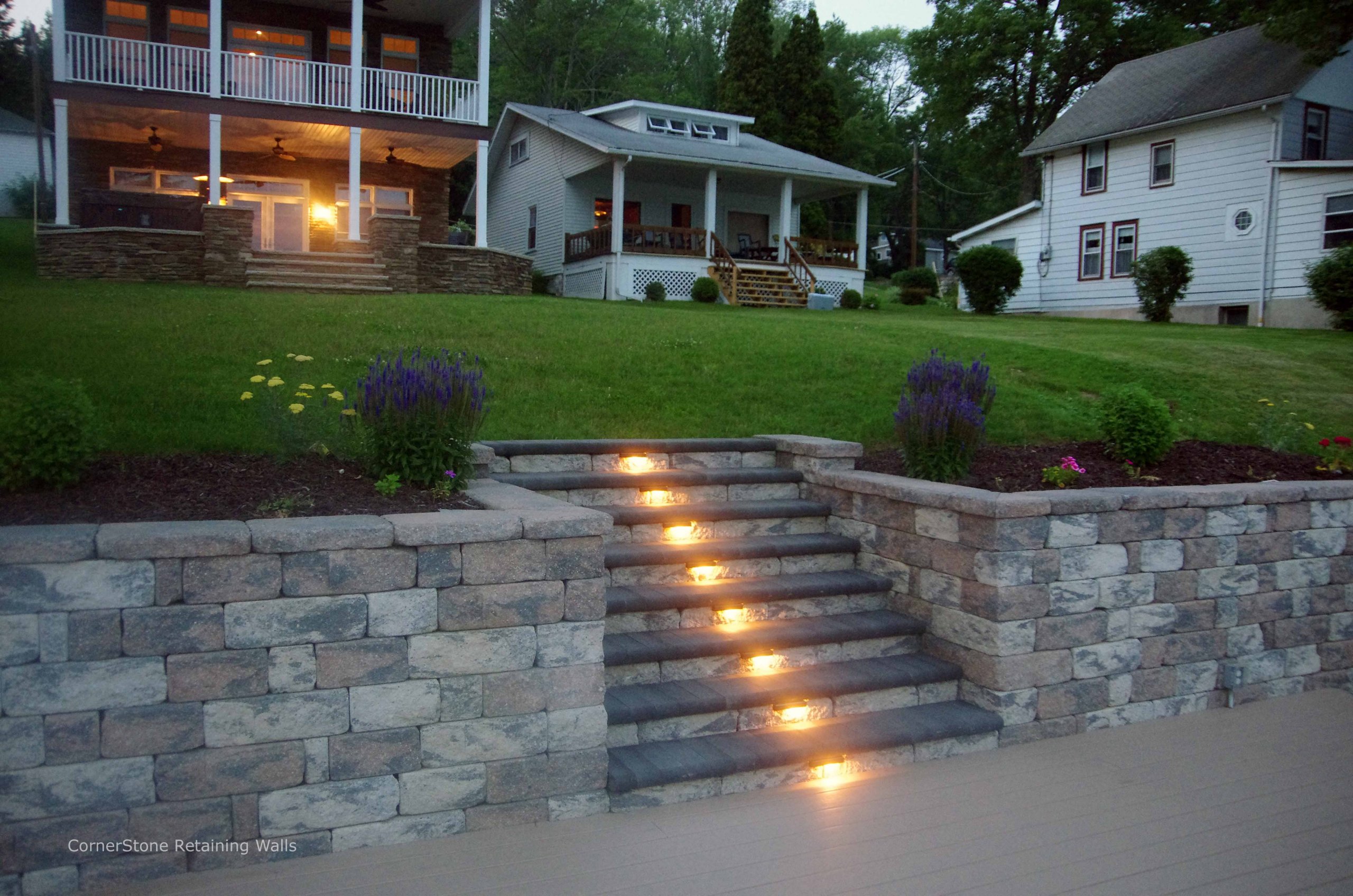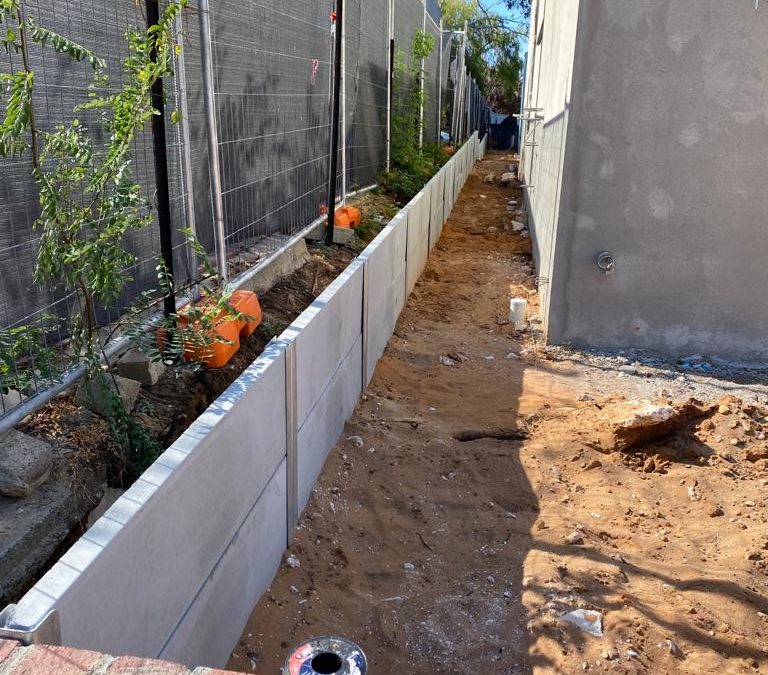Enhancing Property Security: The Role of Retaining Walls in Dirt Retention and Disintegration Control
Keeping walls stand as quiet guardians, playing a critical duty in soil retention and disintegration control. By checking out the subtleties of various kinds, design considerations, building and construction techniques, and maintenance suggestions linked with retaining walls, a much deeper understanding of their critical duty in boosting home stability arises.
Importance of Retaining Walls in Security
The relevance of preserving wall surfaces in making sure stability within landscapes can not be overemphasized. Maintaining wall surfaces play an essential role in keeping back soil, preventing disintegration, and developing level surface areas in sloped locations. By supplying structural assistance, maintaining walls help to redistribute side pressure brought on by dirt, avoiding landslides and slippage. Along with boosting the aesthetic appeal of a residential property, preserving wall surfaces add to the general safety and capability of outdoor rooms.
Maintaining wall surfaces are particularly necessary in irregular or sloping terrains where soil erosion is an usual event. Without ample support, dirt disintegration can bring about the deterioration of landscapes, compromising the stability of structures and posturing threats to residents. Preserving wall surfaces serve as barriers, supporting the dirt and avoiding it from moving downhill during heavy rains or various other ecological stress factors.
In addition, preserving wall surfaces offer long-lasting advantages by reducing maintenance prices related to soil erosion and land instability. By buying well-designed keeping wall surfaces, homeowner can ensure the long life and sustainability of their landscapes while advertising a safe and visually enticing atmosphere.

Kinds Of Retaining Walls for Erosion Control
Gravity retaining wall surfaces are sturdy frameworks that rely on their weight to stand up to the pressure of the soil behind them. Cantilever retaining walls, on the various other hand, are designed with a thicker base and use a bar arm to endure the dirt stress.
For taller walls or where space is a restraint, secured preserving wall surfaces are usually used. When picking the ideal kind of maintaining wall for erosion control, elements such as soil composition, wall elevation, and website conditions should be carefully thought about to make certain long-lasting security and effectiveness.
Layout Factors To Consider for Dirt Retention
When taking into consideration layout aspects for reliable dirt retention remedies,Incorporating the principles of architectural engineering and environmental sustainability is necessary. When making for soil retention, it is vital to analyze the details needs of the website, consisting of dirt composition, water drainage patterns, and slope security. The height and place of the preserving wall surface are essential elements that influence the total layout. Designers have to likewise consider the stress exerted by the retained soil and possible lateral loads to make certain the framework's stability with time.
Additionally, the product choice for the retaining wall is critical in enhancing durability and capability. Concrete, timber, gabion baskets, and natural stone prevail products used in keeping wall surface building and construction, each with its distinct benefits and factors to consider. Correct drainage mechanisms, such as weep holes and French drains, must be incorporated right into the layout to prevent water build-up behind the wall, which can result in structural failing and erosion.
Building Techniques for Keeping Walls
When carrying out style factors to consider for efficient dirt retention, the building techniques for preserving walls play a crucial duty in making sure architectural stability and long-lasting stability. The success of a keeping wall mostly depends on the construction approaches used. One usual method is the gravity wall, which depends on the weight and mass of the wall itself to stand up to the published here stress of the maintained soil. Gravity walls appropriate for reduced to tool heights and are fairly very easy to construct. Retaining Walls Sunshine Coast.
Another click to read more commonly utilized building method is the cantilevered wall surface, which utilizes a concrete piece foundation that expands backwards right into the maintained soil. This layout offers additional stability and is suitable for medium to high retaining wall surfaces. For taller structures, strengthened dirt methods such as making use of geogrids or soil nails can be used to enhance the wall surface's strength and security.

Upkeep Tips for Residential Property Security
To guarantee lasting property stability, routine upkeep techniques are essential for preserving the stability of preventing and keeping walls disintegration problems. Inspecting maintaining wall surfaces occasionally is crucial to identify any signs of damage, such as cracks, bulging, or leaning. Any issues should be addressed quickly to stop additional deterioration. Cleaning the surface area of the preserving wall surfaces can additionally aid preserve their structural stability by removing dirt, particles, and greenery that might weaken the wall surface gradually (Retaining Walls Sunshine Coast).
Along with visual examinations and cleaning, it is important to examine the drain systems connected with the maintaining walls. Ensuring that drains pipes are clear of blockages and functioning effectively can avoid water build-up behind the walls, which can bring about pressure and possible failure. Appropriately functioning drain systems are vital for handling water flow and minimizing the threat of erosion.
Routinely keeping click to find out more and keeping track of maintaining walls according to these suggestions can expand their lifespan and add to the general security of the property.
Final Thought
In conclusion, retaining wall surfaces play a critical duty in enhancing residential or commercial property stability by preventing dirt disintegration and keeping soil in area. Normal maintenance of retaining walls is vital to guarantee long-term security and security against disintegration.
For taller walls or where space is a restraint, anchored keeping wall surfaces are commonly utilized. These walls make use of wires or strips that are anchored into the dirt or rock behind the wall to give extra support. When choosing the suitable kind of keeping wall surface for erosion control, factors such as dirt composition, wall surface height, and site problems must be meticulously taken into consideration to guarantee long-lasting security and efficiency.
One usual method is the gravity wall surface, which depends on the weight and mass of the wall surface itself to resist the pressure of the retained dirt. Cleaning the surface area of the preserving walls can also help preserve their architectural stability by removing dirt, debris, and greenery that might deteriorate the wall surface over time.